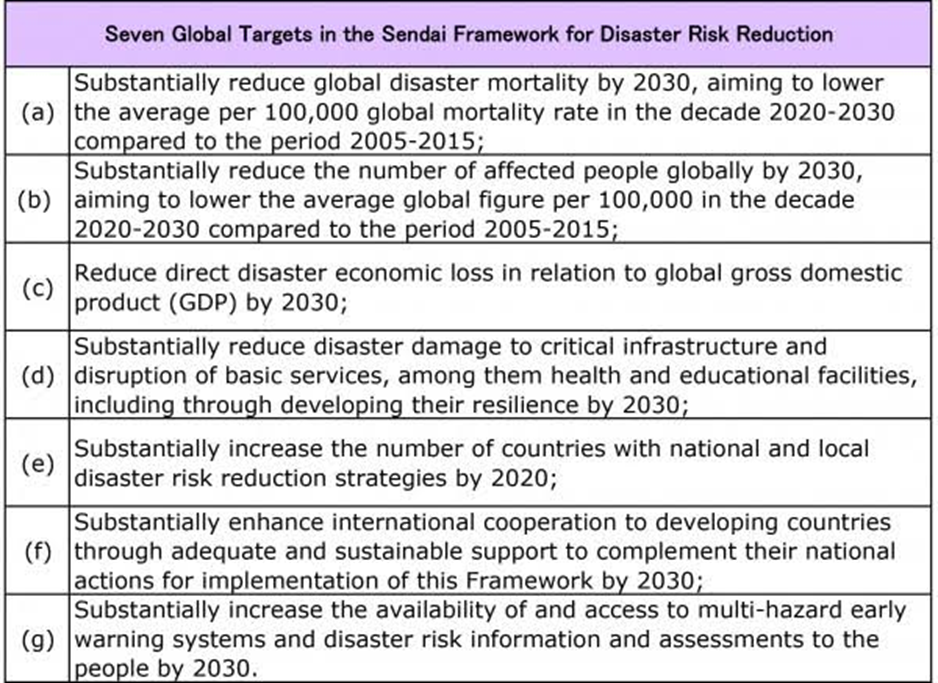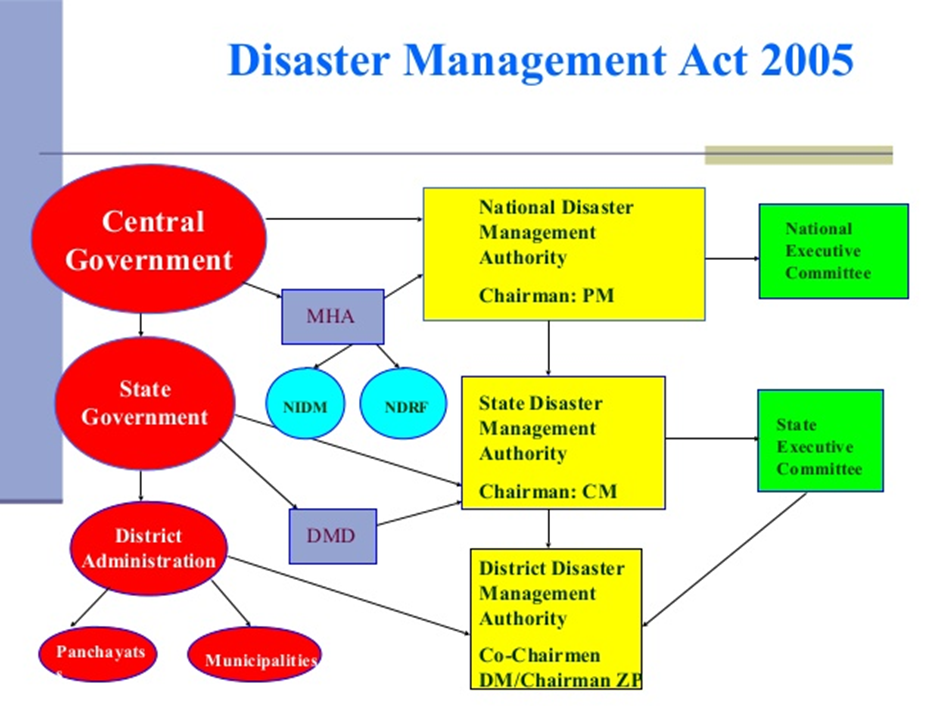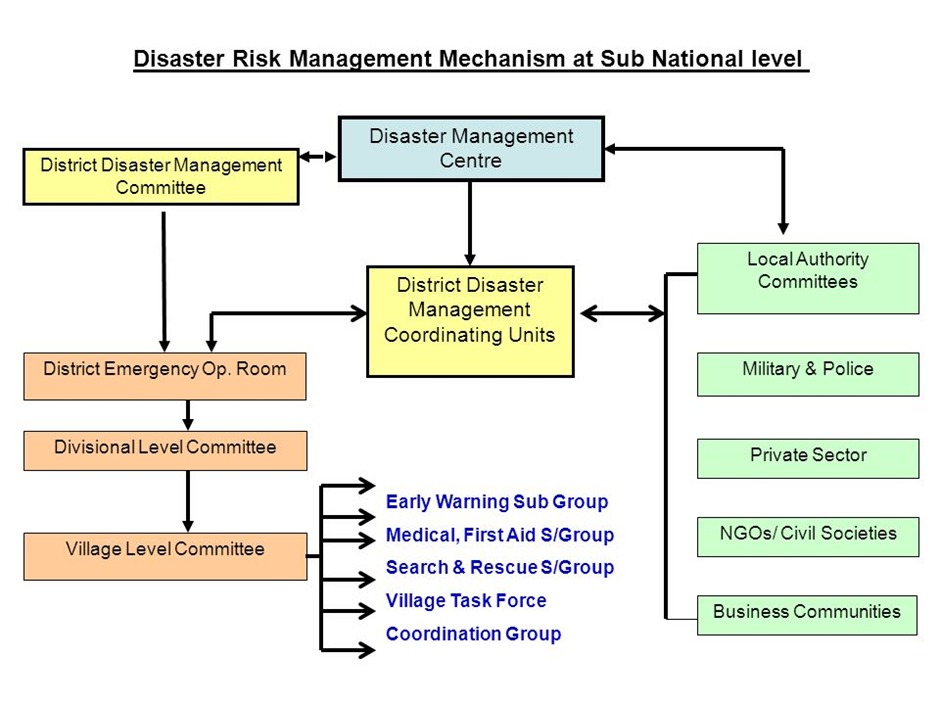PREVIOUS
Disaster Management – Part II
December 7 , 2019
1944 days
25718
0
Organisations related to Disaster Management Framework at Global level
- In 1994, the World Conference on Natural Disaster Reduction was held in Yokohama, Japan.
- The conference adopted the Yokohama strategy and declared the decade 1990-2000 as the International Decade for Natural Disaster Reduction (IDNDR).
- United Nations Office for Disaster Risk Reduction (UNDRR) is the successor to the secretariat of IDNDR and was created in 1999 to implement UN Disaster Risk Reduction strategy.
- The Hyogo Framework for Action (HFA) is a 10-year plan (2005-2015) to make the world safer from natural hazards.
- Priorities such as, Disaster risk reduction, identification, assessment through legal and policy frameworks, disaster preparedness and use of innovation was adopted.
- There are three international agreements within the context of the post - 2015 development agenda. These are:
- The Sendai Framework.
- Sustainable Development Goals 2015-2030
- The Paris agreement (COP 21) on Climate Change.
Sendai Framework for Disaster Reduction 2015-30
- It was adopted at the Third United Nations World Conference on Disaster Risk Reduction, held from March 14 to 18, 2015 in Sendai, Miyagi, Japan.
- The Sendai Framework for Disaster Risk Reduction 2015-2030, is the successor instrument to the Hyogo Framework.
- It is a non-binding agreement, which the signatory nations, including India, will attempt to comply with on a voluntary basis.
- It aims to guide the multi hazard management of disaster risk in development at all levels as well as within and across all sectors.
Actions to be taken in four Priority Areas
- Understanding Disaster Risk.
- Strengthening disaster risk governance to manage disaster risk.
- Investing in disaster risk reduction for resilience.
- Enhancing disaster preparedness for effective response and to “Build Back Better” in recovery, rehabilitation and reconstruction.

Organisations and Policies related to Disaster Management Framework at National level
National Disaster Management Authority of India (NDMA)
- It was established in 2005, under the Disaster Management Act 2005.
- The objective of NDMA is, to build a safer and disaster resilient India by a holistic, proactive, technology driven and sustainable development strategy.
- The NDMA is chaired by the Prime Minister of India and has a vice chairman with the status of Cabinet Minister and eight members with the status of Ministers of State.
- The NDMA Secretariat is headed by a Secretary and deals with mitigation, preparedness, plans, reconstruction, community awareness and financial and administrative aspects.
- It works under the Ministry of Home Affairs.

National Disaster Management Plan (NDMP)
- It was released in 2016, it is the first ever national plan prepared in the country for disaster management.
- With National Disaster Management Plan (2016) India has aligned its National plan with the Sendai Framework for Disaster Risk Reduction 2015-2030, to which India is a signatory.
- The objective of the plan is
- To make India disaster resilient, achieve substantial disaster risk reduction.
- To significantly decrease the losses of life, livelihoods, and assets in terms of economic, physical, social, cultural, and environmental.
- To maximize the ability to cope with disasters at all levels of administration as well as among communities.
State Disaster Management Authority (SDMA)
- At State level, State Disaster Management Authority was established under Disaster Management Act 2005.
- SDMA is chaired by the Chief Minister of the State and has not more than eight members who are appointed by the Chief Minister.
- The SDMA prepares the state disaster management plan and implements the National Disaster Management Plan.
Organisational Set up
- The State Government envisages management of such disasters through following institutions /organisations.
- The State Disaster Management Authority headed by the Hon’ble Chief Minster shall be the Governing Council.
- Revenue Administration Disaster Management and Mitigation Department headed by the State Relief Commissioner
- District administration headed by the Collector
- Sub Divisional Officers (RDOs) assisted by the taluk Tahsildars and other revenue officials.
- Local bodies like Corporations, Municipalities, Panchayat Unions, etc.
- Non-Governmental Organisations.
- Public Sector/Private Sector
- Community.
Tamil Nadu State Disaster Management Authority
- The Authority has been established with the Hon’ble Chief Minister as the Chairperson.
- The Revenue Administration, Disaster Management and Mitigation Department (RADMMD), is in the process of strengthening disaster management capacity in the State by providing access to essential facilities, creating support systems and building human capacities.
- State Disaster Management Policy was prepared during the year 2003.
- Objectives of the Policy
- To replace the existing approach of re-active relief by a proactive approach.
- To develop a new culture of prevention, preparedness and quick response for management of disasters.
- To reduce the vulnerability of the community through proper risk assessment.
- To Identify and utilise the available resources efficiently.
- To ensure transparent, consistent and equitable relief to the victims.
- Details of existing Early Warning System in the State: Hotline between Indian Meteorological Department and the State Emergency Operation Centre (EOC) is established.
- State Disaster Response Force (SDRF) is being constituted by designating Tamil Nadu Special Police (TSP) Battalion II, Avadi.
- State level Resource Database: A database of trained personnel, Disaster Management related studies etc., is being developed.
- Capacity building programmes:
- Training of NGOs on Disaster Management under various programmes are underway.
- Mock drills are conducted for Cyclone, industrial hazards periodically.
- The Government of Tamil Nadu with the following strategic intent paved way for the realizing the objectives under long term rehabilitation.
- Reconstruct damaged and vulnerable houses using disaster resistant features.
- Undertake vulnerability mapping to locate new habitations in safer locations
- Create new sustainable livelihood options in harmony with environment.
- From SHGs, especially for the weaker sections to empower them.
- Information, Education and Communication (IEC) materials such as Posters, Pamphlets, Booklet, Video documentary, Social advertisement are produced.
- Strengthening of Emergency Response at Hospitals.
- Assessment of Hazard, Vulnerability and Risk in vulnerable districts.
- Provide better physical infrastructure.
- Address psychological trauma and educational needs of children for an improved future.
- Funding
- Funds allotted under State Disaster Response Fund would be able to meet the requirement in normal circumstances.
- If additional resources were required the same would be sought from National Disaster Response Fund.
- In case of industrial/chemical disasters, concerned unit would be asked to provide the required funds.
- Role of Central Agencies
- Government recognises the importance of Military, Para Military forces, Civil aviation authorities, Railways, Telecom, Port authorities and central PSUs., in effective management of disasters.
- Accordingly, their representatives would be involved in various meetings/Committees and Government would maintain regular interaction/contact with them to facilitate their cooperation in all disaster management and mitigation activities.
- Key Components of Tamil Nadu Disaster Management Programme
- Government would establish a Disaster Management Authority (DMA), a Nodal agency to guide, facilitate, coordinate and monitor various aspects of disaster management.
- Government would take steps to formulate comprehensive disaster management plans at all levels after taking into account the local conditions.
- Government of Tamil Nadu would focus on the reduction of vulnerability of communities instead of mere disaster relief.
- Government would give due importance to NGOs, community-based organisations and other voluntary/philanthropic institutions.
- Government would not discriminate on the basis of caste, creed, community or sex while distributing the assistance/relief.
District Disaster Management Authority (DDMA)
- Under Disaster Management Act 2005, every State government shall establish a DDMA for every district in the State.
- The DDM Authority shall consist of:
- Chairperson - the Collector or District Magistrate or Deputy Commissioner act as Chairperson of DDMA.
- Co-Chairperson - is the elected representative of the local authority. In the Tribal Areas, the Chief Executive Member of the district council is the co-chairperson.
- There are not more than seven other members in DDMA.
- The Disaster Management Committee governed under District Magistrate will formulate village level disaster management plans for concern villages.
- The DDMA makes District Disaster Management Plan and implements the state Disaster Management Plan.

Government Initiatives
- India is a signatory to the Sendai Framework for Disaster Risk Reduction and is committed to achieve its priorities and objectives.
- India is one of the participating countries and works closely with the United Nations International Strategy for Disaster Reduction (UNISDR).
- National Disaster Management Plan (NDMP) defines the roles and responsibilities of various stakeholders including Central Ministries/ Departments, State Governments, UT Administrations, District Authorities and local self-Governments.
- Primary responsibility of disaster management rests with the States. The Central Government conducts regular mock drill, community training and awareness programme to prepare the civilian populations for disasters.
- NDMA has taken an initiative on Earthquake Disaster Risk Indexing (EDRI) for 50 important cities and 1 District in Seismic Zone IV & V areas.
- NDMA has prepared Upgraded Earthquake Hazard Maps and Atlases for the country for better planning and policies.
- Leveraging the technology of geographic information system (GIS), NDMA have taken up a project for disaster risk management by establishing GIS Server and creation of database.
- The Aapdamitra scheme of NDMA has provision for training 6000 community volunteers in disaster response in 30 most flood prone districts (200 volunteers per district) in 25 States.
- Core Group has been formed for Preparation of Guidelines to avert Boat Tragedies in India.
Issues
- There are significant gaps in preparedness on various aspects of risk management, particularly for catastrophic disasters like major earthquakes and floods.
- Facilities such as emergency operations centres, emergency communications, and search and rescue teams are need to be strengthened.
- The preparedness at various levels are not people-oriented.
- India’s capacity to manage disaster risk is challenged by its size and huge population.
- The country is likely to have the greatest exposure of any nation in the world to extreme weather and natural disasters by 2030.
- The northeast region is most at risk from earthquakes and lacks seismically secure infrastructure and buildings.
- It is also vulnerable to landslides, floods and erosion.
- As a result, risk-reduction activities are driven by schemes and external projects, rather than by guidelines in SDMPs.
Conclusion
- Disasters are no longer to be considered as occurrences that are to be managed through emergency response services.
- So, there is a need to foster a culture of prevention and identification of the key issues to be addressed especially in the development process.
- The path ahead for managing disasters is to bring in a people-centered development strategy.
ó ó ó ó ó ó ó ó ó ó
Leave a Reply
Your Comment is awaiting moderation.


